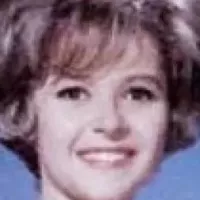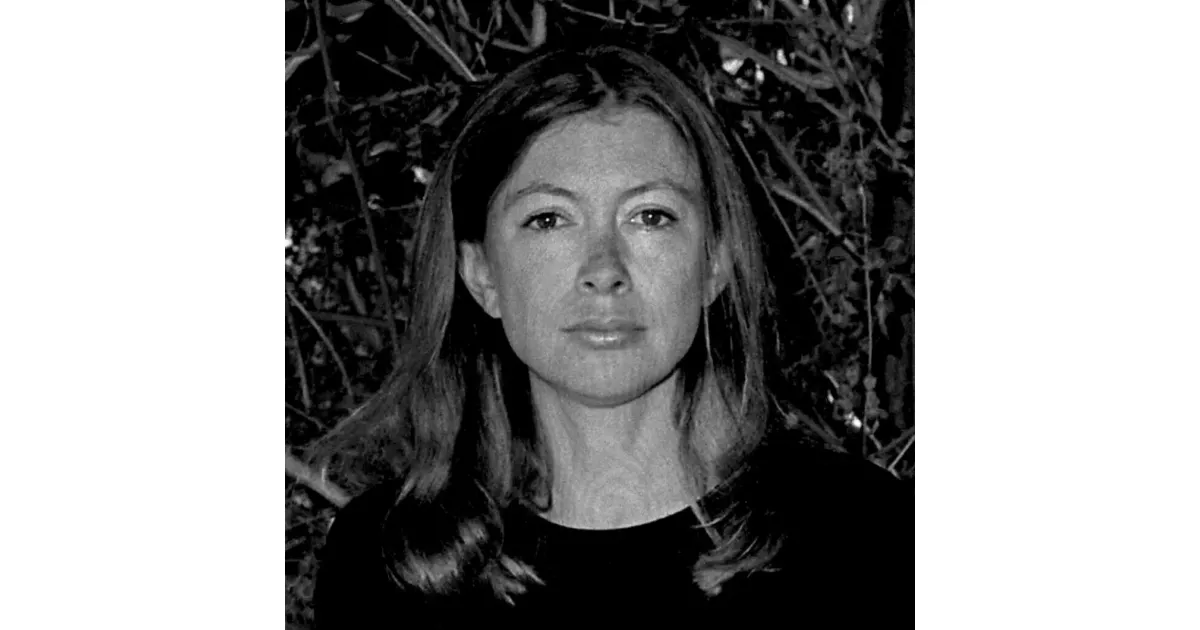Joan Didion was a prominent American writer and journalist, recognized as a pioneer of New Journalism. Her work is characterized by its distinctive style, blending personal experience with sharp social and cultural commentary. She explored themes of American identity, morality, and the disintegration of societal values, often focusing on the anxieties and alienation of modern life. Her notable works include essays and novels reflecting on her own life, California culture, and the political landscape of the United States. Didion's incisive observations and introspective prose have cemented her legacy as a significant voice in contemporary literature.
December 5, 1934: Joan Didion's Birth
On December 5, 1934, Joan Didion, the American writer and journalist, was born. She later became known as one of the pioneers of New Journalism.
1943: Family returned to Sacramento
In 1943, Joan Didion's family returned to Sacramento, California, and her father went to Detroit to negotiate defense contracts for World War II.
1944: Family returned to Sacramento
In early 1944, Joan Didion's family returned to Sacramento, California, and her father went to Detroit to negotiate defense contracts for World War II.
1956: Started working at Vogue
In 1956, Joan Didion began her seven-year tenure at Vogue, starting as a promotional copywriter and eventually becoming an associate feature editor.
1956: Graduation from Berkeley and Vogue Essay Contest Win
In 1956, Joan Didion graduated with a B.A. in English from the University of California, Berkeley. During her senior year, she won first place in the "Prix de Paris" essay contest, sponsored by Vogue, which led to her being awarded a job as a research assistant at the magazine.
1957: Relationship with Noel E. Parmentel Jr. begins
In 1957, Joan Didion began a relationship with Noel E. Parmentel Jr., a political pundit. The relationship lasted for several years.
January 1960: Publication of "Berkeley's Giant: The University of California" in Mademoiselle
In January 1960, Joan Didion's article, "Berkeley’s Giant: The University of California" was published in Mademoiselle magazine.
1962: Relationship with Noel E. Parmentel Jr. ends
In 1962, Joan Didion's relationship with Noel E. Parmentel Jr. ended. During their relationship, Didion wanted to have a child, but Parmentel did not.
1963: Publication of Run, River
In 1963, Joan Didion published her first novel, Run, River, which tells the story of a Sacramento family falling apart. Her friend John Gregory Dunne helped her edit the book.

January 1964: Marriage to John Gregory Dunne
In January 1964, Joan Didion married John Gregory Dunne. They remained together until his death in 2003.
1964: Move to Los Angeles
In 1964, Joan Didion and her husband John Gregory Dunne moved to Los Angeles, California. Although they initially intended to stay only temporarily, California became their home for the next 20 years.
1964: Marriage to John Gregory Dunne
In 1964, Joan Didion married writer John Gregory Dunne, who had helped her edit her first novel. At the time of their marriage, Dunne was writing for Time magazine.
1966: Adoption of Daughter Quintana Roo Dunne
In 1966, Joan Didion and her husband, John Gregory Dunne, adopted a daughter and named her Quintana Roo Dunne.
1968: Psychiatric Evaluation
During the summer of 1968, Joan Didion underwent psychiatric evaluation after experiencing an episode that included vertigo and nausea.
1968: Publication of Slouching Towards Bethlehem
In 1968, Joan Didion published her first nonfiction book, Slouching Towards Bethlehem, a collection of magazine pieces about her experiences in California.
1968: Writing essays
In 1968, Joan Didion wrote essays that appeared in a collection of 12 essays published in 2021.
1970: Publication of Play It as It Lays
In 1970, Joan Didion's novel Play It as It Lays, which is set in Hollywood, was published.
1971: Screenplay for The Panic in Needle Park
In 1971, Joan Didion and her husband John Gregory Dunne wrote the screenplay for The Panic in Needle Park.
1972: Film Adaptation of Play It as It Lays
In 1972, Joan Didion and her husband co-wrote a film adaptation of her novel Play It as It Lays. The movie starred Anthony Perkins and Tuesday Weld.
1972: Diagnosis of Multiple Sclerosis
In 1972, after experiencing periods of partial blindness, Joan Didion was diagnosed with multiple sclerosis, but she remained in remission throughout her life. She also experienced chronic migraines.
1976: Screenplay for A Star Is Born
In 1976, Joan Didion and her husband John Gregory Dunne wrote the screenplay for A Star Is Born.
1976: "Why I Write" Published
In 1976, Joan Didion's article "Why I Write" was published in The New York Times, in which she discussed the importance of sentence structure to her work.
1977: Publication of A Book of Common Prayer
In 1977, Joan Didion published her novel A Book of Common Prayer.
1979: Death of Henry Robbins
In 1979, Henry Robbins, who was Joan Didion's friend and editor, passed away.
1979: Publication of The White Album
In 1979, Joan Didion published The White Album, which is another collection of her magazine pieces from various publications.
1980: Barbara Grizzuti Harrison's Criticism
In 1980, Barbara Grizzuti Harrison wrote a notorious essay, "Joan Didion: Only Disconnect," criticizing Didion's style and subject matter.
1983: Publication of Salvador
In 1983, Joan Didion's book-length essay Salvador was published after a two-week trip to El Salvador with her husband.
1987: Publication of Miami
In 1987, Joan Didion's nonfiction book Miami, which looked at the different communities in that city, was published.
1988: Move to New York City
In 1988, Joan Didion and her husband moved from California to New York City.
1989: Featured in Gap Campaign
In 1989, Joan Didion was featured in a campaign for the clothing company Gap.
1991: Article on the Central Park Five
In 1991, Joan Didion wrote a piece in the New York Review of Books dissecting serious flaws in the prosecution's case against the Central Park Five, suggesting they were wrongfully convicted due to a sociopolitical narrative with racial overtones.
1991: Earliest Mainstream Media Article on the Central Park Five
In 1991, Joan Didion wrote the earliest mainstream media article to suggest that the Central Park Five had been wrongfully convicted.
1992: Publication of After Henry
In 1992, Joan Didion published After Henry, a collection of twelve geographical essays and a personal memorial for her friend and editor, Henry Robbins.
1996: Screenplay for Up Close & Personal
In 1996, Joan Didion and her husband John Gregory Dunne wrote the screenplay for Up Close & Personal.
1996: Publication of The Last Thing He Wanted
In 1996, Joan Didion published The Last Thing He Wanted, a romantic thriller.
1996: Noel E. Parmentel Jr. Interview
In 1996, Noel E. Parmentel Jr. was interviewed for an article in New York magazine, breaking a long-held silence on Joan Didion. He had been angered in the 1970s by what he felt was a thinly veiled portrait of him in Didion's novel, A Book of Common Prayer.
2000: Writing essays
In 2000, Joan Didion wrote essays that appeared in a collection of 12 essays published in 2021.
2003: Daughter's Illness and Husband's Death
In 2003, Joan Didion's daughter, Quintana Roo Dunne, developed pneumonia that progressed to septic shock and was comatose in an intensive-care unit. While her daughter was ill, Didion's husband, John Gregory Dunne, suddenly died of a heart attack on December 30.
2003: Death of John Gregory Dunne
In 2003, John Gregory Dunne, Joan Didion's husband, died from a heart attack.
2003: Memoir Where I Was From
In her 2003 memoir Where I Was From, Joan Didion wrote that moving so often as a child made her feel like a perpetual outsider.
October 4, 2004: Began Writing The Year of Magical Thinking
On October 4, 2004, at the age of 70, Joan Didion began writing The Year of Magical Thinking, a narrative of her response to the death of her husband and the severe illness of their daughter. She completed the manuscript in 88 days, on New Year's Eve.
2004: Quintana's Fall at the Airport
In 2004, after her father's funeral, Quintana Roo Dunne fell at the airport in Los Angeles, hit her head, and required brain surgery for hematoma.
August 26, 2005: Death of Quintana Roo Dunne
On August 26, 2005, Quintana Roo Dunne, Joan Didion's daughter, died of acute pancreatitis at the age of 39 during Didion's New York promotion for The Year of Magical Thinking.
2005: Living in Manhattan
In 2005, Joan Didion was living in an apartment on East 71st Street in Manhattan.
2005: National Book Award for The Year of Magical Thinking
In 2005, Joan Didion won the National Book Award for Nonfiction for her memoir The Year of Magical Thinking.
2006: Publication of We Tell Ourselves Stories in Order to Live
In 2006, Everyman's Library published We Tell Ourselves Stories in Order to Live, a compendium of much of Joan Didion's writing, including her first seven published nonfiction books, with an introduction by John Leonard.
2007: Stage Adaptation of The Year of Magical Thinking
In 2007, Joan Didion began working with playwright David Hare on a one-woman stage adaptation of The Year of Magical Thinking. The Broadway play was produced by Scott Rudin and featured Vanessa Redgrave.
2007: Broadway Premiere of The Year of Magical Thinking
In 2007, Joan Didion's book The Year of Magical Thinking was adapted into a play that premiered on Broadway.
2011: Smoking Habit
As late as 2011, Joan Didion smoked precisely five cigarettes per day.
2011: Publication of Blue Nights
In 2011, Joan Didion wrote about her daughter Quintana's death in the book Blue Nights.
2011: Reaction to Criticism
In 2011, New York magazine reported that Joan Didion still felt strongly about Barbara Grizzuti Harrison's criticism from 1980.
2012: Screenplay Collaboration with Todd Field
In 2012, Joan Didion and Todd Field collaborated on writing a screenplay titled As It Happens, a political thriller, but the project never came to fruition due to a lack of studio backing.
2013: National Humanities Medal
In 2013, Joan Didion was awarded the National Humanities Medal by President Barack Obama.
2015: Céline Campaign
In 2015, a photograph of Joan Didion shot by Juergen Teller was used as part of the spring-summer campaign of the luxury French fashion brand Céline.
2017: Netflix Documentary The Center Will Not Hold
In 2017, Joan Didion was profiled in the Netflix documentary The Center Will Not Hold, directed by her nephew Griffin Dunne.
December 23, 2021: Joan Didion's Death
On December 23, 2021, Joan Didion, the American writer and journalist, passed away.
2021: Publication of Let Me Tell You What I Mean
In 2021, Joan Didion published Let Me Tell You What I Mean, a collection of 12 essays she wrote between 1968 and 2000.
2022: Joan Didion: What She Means Exhibition Organized
In 2022, the Hammer Museum at University of California, Los Angeles, organized the exhibition Joan Didion: What She Means. The group show was curated by Hilton Als.
2023: Joan Didion: What She Means Exhibition Travels to Miami
In 2023, the Joan Didion: What She Means exhibition is scheduled to travel to the Pérez Art Museum Miami.
Mentioned in this timeline

Cher an American singer actress and television personality is celebrated...

Barack Obama the th U S President - was the...
California is a U S state on the Pacific Coast...

Los Angeles is the most populous city in California and...

Robert Redford was a highly acclaimed American actor director and...

Miami is a major coastal city located in Florida United...
Trending
7 months ago Arkansas Razorbacks Dominate, Advance to NCAA Super Regionals: Fayetteville Celebrates Victory

7 months ago Lutnick's El Salvador crypto ties scrutinized amid Trump Commerce Secretary's stake.

Brenda Lee known as Little Miss Dynamite is an American singer prominent in rockabilly pop country and Christmas music Achieving...

2 months ago Barron Trump's Height, Dating Life, and Eric Trump's Advice Spark Discussion

7 months ago Elysée Denies Macron Slapped by Brigitte in Vietnam; Claims Playful Moment

4 months ago Colorado Lottery results: Pick 3 Midday and Evening winning numbers for August 14, 2025.
Popular

Candace Owens is an American conservative political commentator and author...
Matt and Ross Duffer known as the Duffer Brothers are...

Ilhan Omar is an American politician currently serving as the...

XXXTentacion born Jahseh Dwayne Ricardo Onfroy was a controversial yet...

Tom Cotton is an American politician and Army veteran currently...
The Kennedy Center Honors are annual awards recognizing individuals and...













